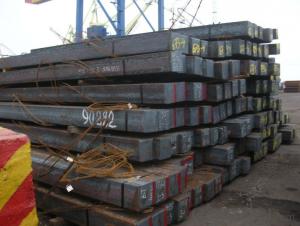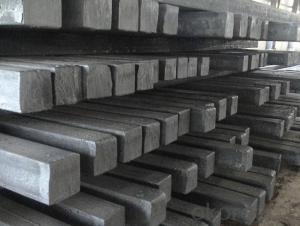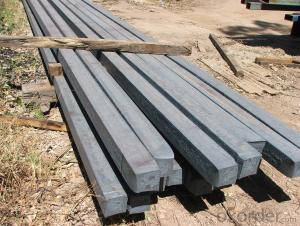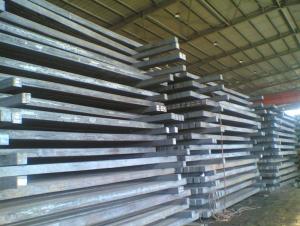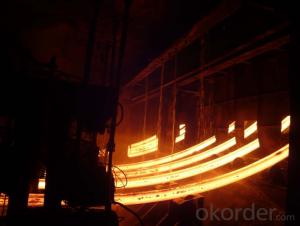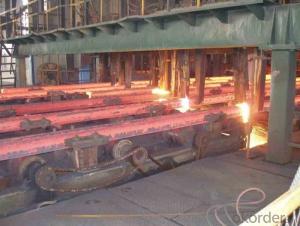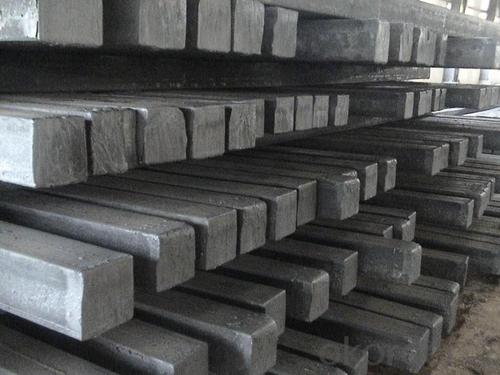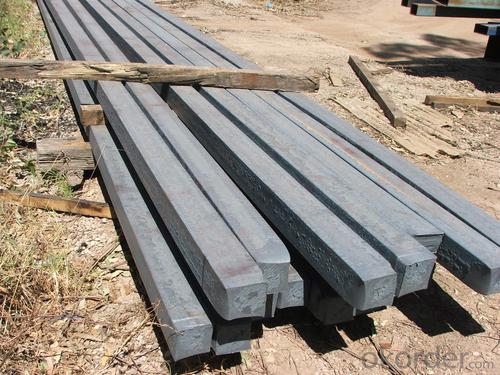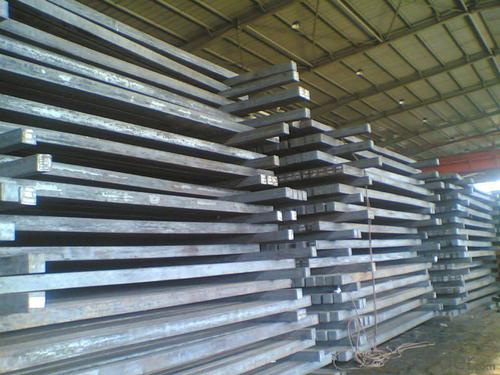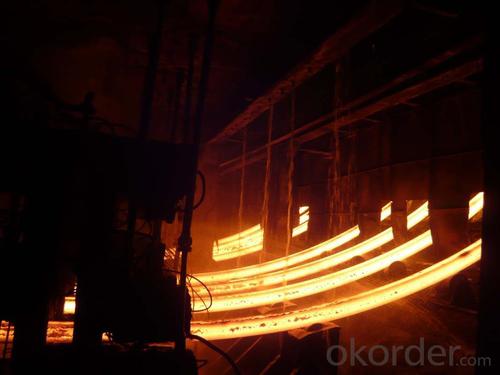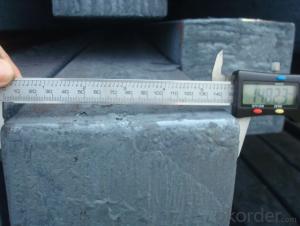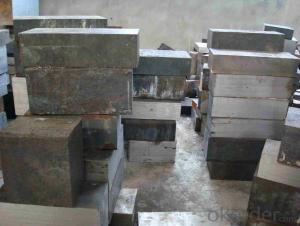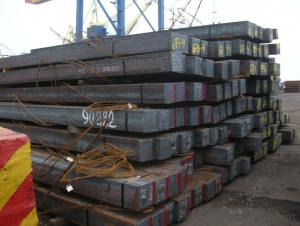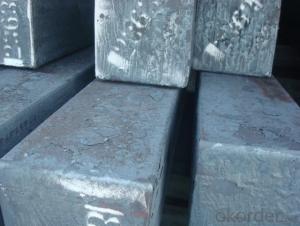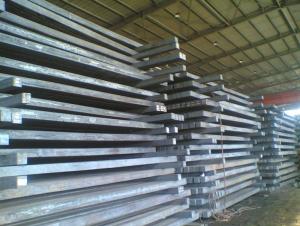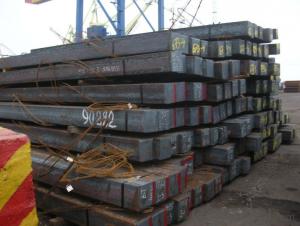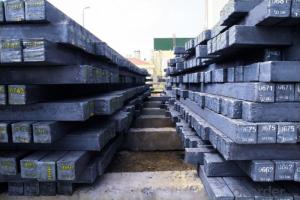Hot Rolled Square Steel Billet 3SP Standard 195mm
- Loading Port:
- Shanghai
- Payment Terms:
- TT OR LC
- Min Order Qty:
- 2000 m.t.
- Supply Capability:
- 10000 m.t./month
OKorder Service Pledge
OKorder Financial Service
You Might Also Like
Structure of Hot Rolled Square Steel Billet 3SP Standard 195mm
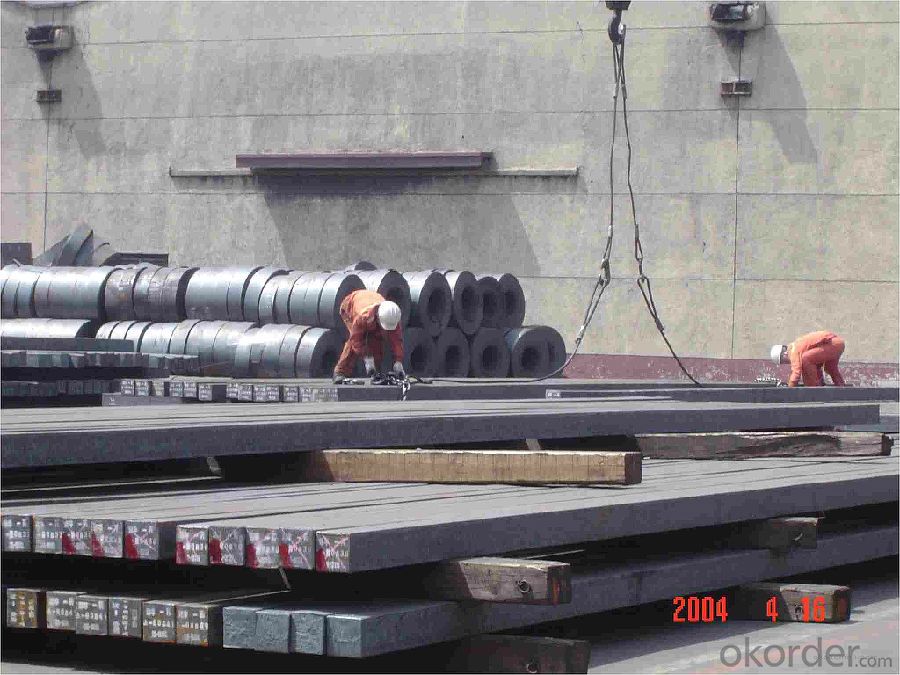
Description of Hot Rolled Square Steel Billet 3SP Standard 195mm
PPGI is made by cold rolled steel sheet and galvanized steel sheets as baseplate, through the surface pretreatment (degreasing, cleaning, chemical conversion processing), coated by the method of continuous coatings (roller coating method),
and after roasting and cooling. Zinc coating: Z60, Z80, Z100, Z120, Z180, Z275, G30, G60, G90
Alu-zinc coating: AZ60, AZ80, AZ100, AZ120, AZ180, G30, G60, G90
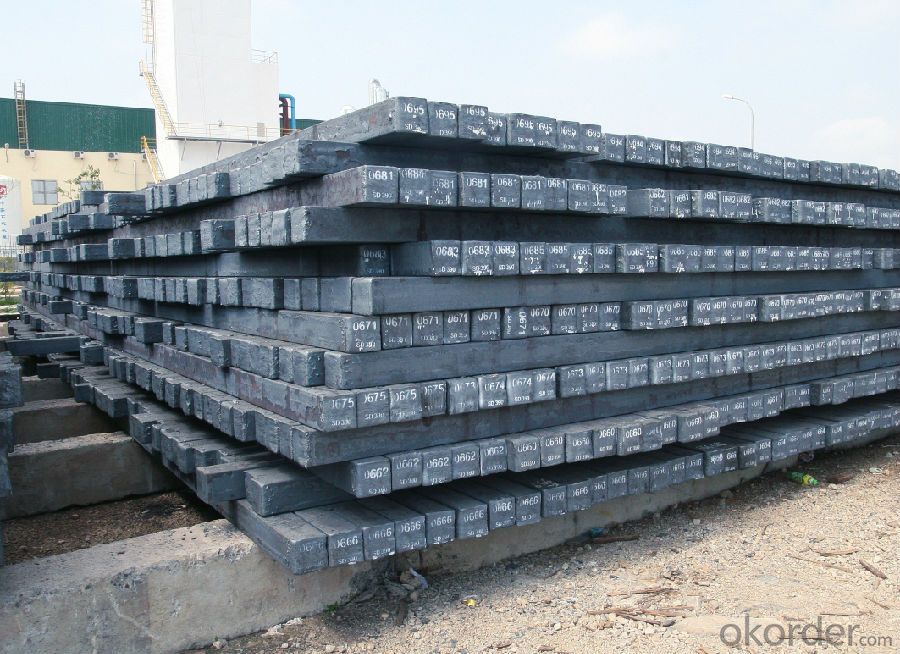
Main Feature of Hot Rolled Square Steel Billet 3SP Standard 195mm
1) Excellent corrosion resistance: The zinc layer provides a good protection of Pre-painted Galvanizeed Steel Sheet.
2) High heat resistance: The reflective surface of the material aids in efficiently reflecting the sunlight away and in turn reducing the amount of heat transmitted. The thermal reflectivity converts into energy savings.
3) Aesthetics: Pre-Painted Galvanized steel sheet is available in plethora of patterns and multiple sizes as per the requirements that given by our customers.
4) Versatility: can be used in the various areas.Standard seaworthy export packing: 3 layers of packing, inside is kraft paper, water plastic film is in the middle and outside GI steel sheet to be covered by steel strips with lock, with inner coil sleeve.
Applications of Hot Rolled Square Steel Billet 3SP Standard 195mm
1) Automotive bodies: filters, fuel tanks, etc.
2) Construction materials: roofings, welding pipes,
3) Electric and electronic appliances: computer cans, etc.
4) Steel cans: containers, etc.
5) Steel furniture: washing machines, refrigerators, microwaves, etc.
6) Drums
7) Office equipment: printer, recorders, etc.
8) Motors and transformers
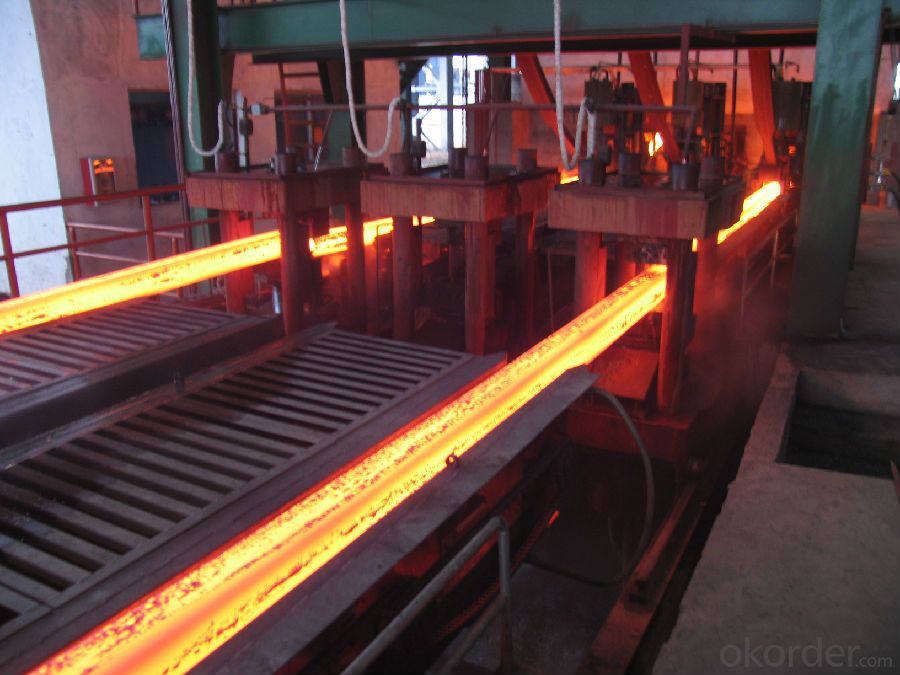
Specifications of Hot Rolled Square Steel Billet 3SP Standard 195mm
| Classified symbol | Yield Point Minimum N/mm2 | Tensile Strength Minimum | Elongation Minimum % | Application | ||||
| N/mm2 | Nominal Thickness mm (t) | |||||||
| JIS | Yogic | 0.25-0.4 | 0.4-0.6 | 0.6-1.0 | 1.0-1.6 | |||
| G3312 | specification | |||||||
| CGCC | CGCC | -205 | -270 | -20 | -21 | -24 | -24 | Commercial |
| CGCD | CGCD | --- | 270 | --- | 27 | 31 | 32 | Drawing |
| --- | CG340 | 245 | 340 | 20 | 20 | 20 | 20 | Structural |
| CGC400 | CG400 | 295 | 400 | 16 | 17 | 18 | 18 | Structural |
| CGC440 | CG440 | 335 | 440 | 14 | 15 | 16 | 18 | Structural |
| CGC490 | CG490 | 365 | 490 | 12 | 13 | 14 | 16 | Structural |
| CGC570 | CG570 | 560 | 570 | --- | --- | --- | --- | Structural |
| ASTM Designation | Yield Point Minimum | Tensile Strength Minimum | Elongation Minimum % | Application | Q/BQB 445-2004(China standard) | ASM A653/A653M | JISG 3312 | |
| ksi(MPa) | ksi(MPa) | TDC51D+Z | (CS TYPE A+Z) | CGCC | ||||
| A653(M)-99 CS TYPE A,B,C | --- | --- | --- | Commercial | TDC52D+Z | CGCD | ||
| A653(M)-99 FS | --- | --- | --- | Lock Forming | TS250GD+Z | (G250+Z) | - | |
| A653(M)-99 DS | --- | --- | --- | Drawing | TS300GS+Z | (G300+Z) | CGC 400 | |
| A653(M)-99 SS Grade33(230) | 33(230) | 45(310) | 20 | Structural | TS350GD+Z | (G350+Z) | CGC490 | |
| A653(M)-99 SS Grade37(255) | 37(255) | 52(360) | 18 | Structural | TS550GD+Z | (G550+Z) | CGC570 | |
| A653(M)-99 SS Grade40(275) | 40(275) | 55(380) | 16 | Structural | ||||
| A653(M)-99 SS Grade50(345) | 50(345) | 65(450) | 12 | Structural | ||||
| A653(M)-99 SS Grade80(550) | 80(550) | 82(570) | --- | Structural | ||||
FAQ of Hot Rolled Square Steel Billet 3SP Standard 195mm
We have organized several common questions for our clients,may help you sincerely:
1. How Can I Visit There?
Our company is located in Tianjin City, China, near Beijing. You can fly to Tianjin Airport Directly. All our clients, from home or aboard, are warmly welcome to visit us!
2. How Can I Get Some Sample?
We are honored to offer you sample.
3. Why choose CNBM?
1, ISO, BV, CE, SGS approved.
2, Competitive price and quality.
3, Efficient service team online for 24 hours.
4, Smooth production ability(50000tons/month) .
5, quick delivery and standard exporting package.
6, Flexible payment with T/T, L/C, Paypal, Kunlun bank, etc.
- Q: How do steel billets contribute to the marine industry?
- The marine industry relies heavily on steel billets, which serve a crucial role in constructing and maintaining marine structures and vessels. These semi-finished steel products offer numerous benefits and are widely used in the marine industry. First and foremost, steel billets possess excellent strength properties and are highly durable. This makes them ideal for withstanding harsh marine conditions like corrosion, extreme temperatures, and high-pressure environments. They are commonly used in building ship hulls, offshore platforms, and other marine structures that face the challenging conditions of the sea. Additionally, steel billets can be easily shaped and molded into various forms, making them versatile for a wide range of marine applications. They can be used to produce different components and parts such as propeller shafts, engine components, pipelines, and structural beams. Moreover, steel billets are vital in manufacturing anchors, chains, and other mooring equipment crucial for securing vessels and offshore structures. Furthermore, steel billets are known for their excellent weldability, which is essential in the marine industry. Regular maintenance, repair, and modification are common requirements for ships and offshore structures. The seamless welding of steel billets allows for efficient repairs and alterations, ensuring the structural integrity and safety of marine vessels and infrastructure. In terms of sustainability, steel billets have a long lifespan and can be recycled multiple times. This makes them an environmentally friendly choice for the marine industry, reducing the need for new raw materials and minimizing environmental impact. To summarize, steel billets are indispensable to the marine industry due to their durability, strength, versatility, weldability, and sustainability. Their qualities enable their use in constructing, repairing, and maintaining marine structures and vessels, ensuring their reliability and longevity in the challenging marine environment.
- Q: What are the main factors affecting the toughness of steel billets?
- There are several main factors that can affect the toughness of steel billets. 1. Composition: The chemical composition of the steel, including the presence of certain elements such as carbon, manganese, and silicon, can significantly impact its toughness. For example, higher carbon content tends to increase hardness but decrease toughness, while the addition of alloying elements like nickel or chromium can improve both strength and toughness. 2. Heat treatment: The heat treatment process, including the rate of cooling and the temperature at which it is performed, can have a significant effect on the toughness of steel. Quenching and tempering are common heat treatment techniques used to enhance the toughness of steel by controlling the microstructure and reducing the presence of brittle phases. 3. Microstructure: The microstructure of steel, which is determined by factors such as cooling rate, grain size, and phase distribution, can greatly influence its toughness. Fine-grained structures tend to exhibit better toughness compared to coarse-grained ones, as smaller grains can inhibit crack propagation. 4. Impurities and inclusions: The presence of impurities and inclusions in steel can negatively impact its toughness. These impurities can act as stress concentrators, leading to localized failure and reduced overall toughness. Therefore, the steelmaking process needs to ensure proper purification and removal of impurities. 5. Manufacturing processes: Various manufacturing processes, such as rolling or forging, can influence the toughness of steel billets. These processes can induce residual stresses and introduce defects that can affect the material's overall toughness. Proper control and optimization of these processes can help enhance the toughness of steel billets. 6. Service conditions: The specific application and service conditions of the steel billets also play a role in determining its toughness requirements. Factors such as temperature, stress levels, and exposure to corrosive environments can impact the material's toughness performance. Understanding and accounting for these conditions is crucial in selecting the appropriate steel grade and ensuring long-term durability. In summary, the main factors affecting the toughness of steel billets include composition, heat treatment, microstructure, impurities, manufacturing processes, and service conditions. By carefully considering and optimizing these factors, manufacturers can produce steel billets with the desired toughness properties for various applications.
- Q: How do steel billets contribute to the construction of bridges and infrastructure?
- Steel billets play a crucial role in the construction of bridges and infrastructure due to their strength, versatility, and durability. These cylindrical bars of steel are produced through a process called casting, where molten steel is poured into molds and allowed to cool and solidify. One of the primary contributions of steel billets to bridge construction is their high load-bearing capacity. Bridges are subjected to heavy loads, such as the weight of vehicles, pedestrians, and even natural forces like wind and earthquakes. Steel billets, with their exceptional strength and structural integrity, provide the necessary support to withstand these loads and ensure the safety and stability of the bridge. Furthermore, steel billets offer flexibility in design and construction. Their malleability allows them to be easily shaped and formed into various structural components, such as beams, columns, and girders, which are essential elements in bridge construction. This flexibility enables engineers to create innovative designs and optimize the use of materials, resulting in cost-effective and efficient bridge structures. Another significant advantage of steel billets is their resistance to corrosion. Bridges are constantly exposed to harsh environmental conditions, including moisture, saltwater, and pollution. Steel billets can be treated with protective coatings or alloyed with elements such as chromium or nickel to enhance their resistance to corrosion. This ensures the longevity and durability of the bridge, reducing maintenance costs and enhancing its lifespan. Additionally, steel billets contribute to the speed of bridge construction. As these billets are prefabricated in steel mills, they can be produced in large quantities and transported to the construction site, ready for assembly. This prefabrication process reduces the time required for on-site construction, minimizing disruption to traffic and reducing overall project duration. In summary, steel billets are integral to the construction of bridges and infrastructure due to their high load-bearing capacity, flexibility in design and construction, resistance to corrosion, and contribution to faster construction times. Their contribution ensures the safety, longevity, and efficiency of bridge structures, making them an essential component in the development of robust and reliable infrastructure systems.
- Q: What is the role of steel billets in the shipbuilding industry?
- The shipbuilding industry relies heavily on steel billets as they are the primary material used to build the structural components of ships. These billets, which are semi-finished steel products, are made by casting molten steel into rectangular shapes that can be further processed into various shipbuilding parts. Using steel billets in shipbuilding offers several advantages. Firstly, they are known for their high strength and durability, making them ideal for withstanding the intense stress and harsh conditions ships face, such as waves, corrosion, and extreme temperatures. This ensures the structural integrity and longevity of the vessel. In addition, steel billets have excellent weldability, which is crucial in shipbuilding as ships have numerous welded joints. The ease and reliability of welding steel billets allow for efficient and cost-effective construction methods, reducing both time and labor required. Furthermore, steel billets provide versatility in ship design. They can be easily shaped and fabricated into different forms and sizes, enabling shipbuilders to create complex structures that optimize space utilization and enhance functionality. This flexibility in design allows for the construction of various types of ships, from cargo vessels and tankers to cruise ships and naval vessels. Moreover, steel billets have excellent resistance to corrosion, which is essential for ships constantly operating in corrosive marine environments. The high-quality steel used in billets protects against rust and deterioration caused by seawater, ensuring the safety and longevity of the vessel. Overall, steel billets are crucial in shipbuilding as they provide the necessary strength, weldability, versatility, and corrosion resistance required for constructing durable and seaworthy ships. Their use as the primary raw material allows for the creation of reliable and efficient vessels capable of withstanding the challenging conditions of the maritime environment.
- Q: What are the different sizes of steel billets?
- The sizes of steel billets can vary depending on the specific requirements and industry standards. However, common sizes range from small billets measuring around 100mm by 100mm to larger ones measuring several meters in length and width.
- Q: How do steel billets contribute to the manufacturing of electrical appliances?
- Steel billets play a vital role in the manufacturing of electrical appliances by providing a strong and durable material for various components. Electrical appliances, such as refrigerators, washing machines, and air conditioners, require sturdy structures to withstand constant usage and external forces. Steel billets, which are semi-finished metal products, are used as a raw material in the manufacturing process to create these robust structures. Firstly, steel billets are forged or rolled into different shapes and sizes to create the frames, chassis, and housing of electrical appliances. These components provide the necessary support and protection for the internal parts of the appliances. The strength and stability of steel make it an ideal choice for withstanding the weight and vibrations generated during the operation of electrical appliances. Additionally, steel billets are used to fabricate the motor cores and transformer cores in electrical appliances. Motor cores are essential for converting electrical energy into mechanical energy, while transformer cores are responsible for regulating the voltage in electrical circuits. Steel's magnetic properties, such as high electrical conductivity and low hysteresis loss, make it an excellent choice for these applications, ensuring efficient energy conversion and transmission. Moreover, steel billets are utilized to manufacture heating elements and electrical contacts in appliances like stoves, ovens, and switches. These components require materials that can withstand high temperatures, resist corrosion, and provide excellent electrical conductivity. Steel billets are often alloyed with other metals, such as nickel or chromium, to enhance these properties, making them highly suitable for such applications. In conclusion, steel billets contribute significantly to the manufacturing of electrical appliances by providing a durable and versatile material for various components. The strength, stability, and magnetic properties of steel make it an essential raw material for creating the frames, motor cores, transformer cores, heating elements, and electrical contacts used in these appliances. Thanks to steel billets, electrical appliances can perform reliably and efficiently, meeting the needs and expectations of consumers.
- Q: What are the potential applications of steel billets in the oil and gas aftermarket?
- Steel billets possess a wide range of potential uses within the oil and gas aftermarket. Initially, they find application in the production of various components for the industry, including valves, flanges, and fittings. These components are indispensable for the efficient functioning and upkeep of pipelines, refineries, and drilling facilities. Moreover, steel billets serve a critical role in the manufacturing of seamless pipes, which are essential for the long-distance transportation of oil and gas. The seamless pipes crafted from steel billets exhibit exceptional strength, durability, and resistance to corrosion, rendering them suitable for the often challenging conditions encountered in the oil and gas industry. Furthermore, steel billets find utility in the production of downhole tools and equipment. These tools are instrumental during drilling operations, enabling the extraction of oil and gas from beneath the Earth's surface. Steel billets provide the necessary strength and toughness to withstand the extreme pressures and temperatures encountered in downhole environments. Additionally, steel billets contribute to the fabrication of storage tanks and vessels utilized in the oil and gas industry. These tanks serve as storage facilities for crude oil, refined products, and natural gas. Steel billets offer exceptional weldability and structural integrity, guaranteeing the reliability and safety of these storage facilities. Moreover, steel billets find application in the construction of offshore platforms and structures. These platforms are integral to drilling, production, and processing activities in offshore oil and gas fields. Steel billets are highly favored in this context due to their outstanding strength, resistance to corrosion, and ability to withstand the harsh marine environment. In conclusion, the potential uses of steel billets within the oil and gas aftermarket are extensive. Whether it is the production of components, seamless pipes, and downhole tools, or the fabrication of storage tanks and offshore platforms, steel billets play a crucial role in supporting the operations of the oil and gas industry.
- Q: How are steel billets used in the production of building facades?
- Steel billets are an important component in the production of building facades due to their versatility and strength. Building facades are the external covering or cladding of a building, which not only provides an aesthetic appeal but also serves as a protective barrier against external elements. Steel billets, which are semi-finished steel products, are used in the production of building facades in several ways. Firstly, they are often used as the primary material for the structural framework of the facade. Steel billets are known for their high strength-to-weight ratio, making them an ideal choice for supporting the weight of the facade and providing structural stability to the building. Additionally, steel billets can be further processed to create various shapes and profiles required for the design of the facade. These shapes can be formed through processes such as hot rolling, cold rolling, or extrusion, allowing for intricate and customized designs. This flexibility in shaping steel billets enables architects and designers to create unique and aesthetically pleasing facades that enhance the overall appearance of the building. Steel billets are also used in the production of curtain wall systems, which are commonly utilized in modern building facades. Curtain walls are lightweight, non-structural cladding systems that are attached to the building's structural framework. Steel billets are often utilized in the creation of curtain wall support systems, providing the necessary strength and durability to withstand wind loads, seismic forces, and other external pressures. Moreover, steel billets can be coated or treated with various finishes to enhance their corrosion resistance and improve their longevity. These finishes can range from galvanization to powder coating, ensuring that the building facade remains durable and aesthetically appealing over time. In summary, steel billets play a crucial role in the production of building facades by providing strength, flexibility in design, and durability. Their utilization in the structural framework, creation of customized shapes, support systems for curtain walls, and application of protective finishes make them an indispensable material in the construction industry.
- Q: Can steel billets be used in the production of bicycles?
- Certainly! Bicycles can indeed utilize steel billets in their production. Steel billets, which are partially finished products derived from steel, can undergo further processing to attain a wide range of shapes and sizes. When it comes to bicycles, these steel billets can be molded and fashioned into diverse components such as frames, forks, handlebars, and other structural elements. Steel remains a popular choice for bicycle production due to its commendable attributes of strength, durability, and cost-effectiveness. It offers exceptional rigidity, stability, and resistance to deformation, rendering it suitable for various bicycle types including road bikes, mountain bikes, and hybrid bikes. Furthermore, steel can be readily welded, enabling customization and facilitating the repair of bicycle frames.
- Q: What are the different types of steel billet surface defects?
- There are several types of steel billet surface defects, including cracks, scale, surface laps, scratches, and pitting.
Send your message to us
Hot Rolled Square Steel Billet 3SP Standard 195mm
- Loading Port:
- Shanghai
- Payment Terms:
- TT OR LC
- Min Order Qty:
- 2000 m.t.
- Supply Capability:
- 10000 m.t./month
OKorder Service Pledge
OKorder Financial Service
Similar products
Hot products
Hot Searches
Related keywords
